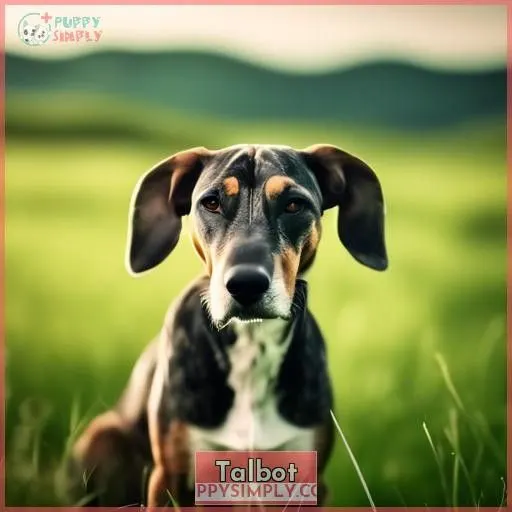This site is supported by our readers. We may earn a commission, at no cost to you, if you purchase through links.
The English White Terrier, known for its distinctive appearance, and the versatile Talbot, once valued for its hunting prowess, have vanished.
The Salish Wool Dog, a culturally significant breed from the Pacific Northwest, fell victim to changing times.
The Moscow Water Dog and Tweed Water Spaniel, adapted to aquatic environments, also met their demise.
These peculiar breeds, each with their own intriguing tales, stand as reminders of the dynamic tapestry of canine diversity that has been woven throughout history. Uncover more about these intriguing lost breeds by investigating further.
Table Of Contents
- Key Takeaways
- English White Terrier
- Talbot
- Salish Wool Dog
- Moscow Water Dog
- Tweed Water Spaniel
- Frequently Asked Questions (FAQs)
- What was the breeding process of the Moscow Water Dog?
- How did the Moscow Water Dog differ from other rescue dog breeds?
- What were the primary roles of the Moscow Water Dog in the Russian Navy?
- How did the Moscow Water Dogs temperament impact its development as a breed?
- What were the common health issues faced by the Moscow Water Dog?
- Conclusion
Key Takeaways
- The English White Terrier, Talbot, Salish Wool Dog, Moscow Water Dog, and Tweed Water Spaniel are examples of peculiar extinct dog breeds that once played significant roles in their respective communities.
- The English White Terrier was a breed that was bred to create new species but became extinct due to a lack of public interest, highlighting the challenges in genetic preservation and the historical significance of these dogs.
- The Talbot was an ancestor of both Beagles and Bloodhounds, known for its exceptional scenting abilities, and was a perfect hunting partner in the 18th century.
- The Salish Wool Dog was a breed that was a master of wool production and had significant cultural significance among indigenous peoples, but its legacy was sheared from history, leaving a patchwork of mystery.
- The Moscow Water Dog, also known as the Moscow Diver, Moscow Retriever, or Moscow Vodolaz, was a unique breed developed in the Soviet Union for water rescues, but its aggressive nature led to its downfall, and it is now a forgotten chapter in canine history.
English White Terrier
The English White Terrier was an extinct dog breed that was bred to create new species. However, it became extinct due to a lack of public interest.
This breed, like other extinct dog breeds, serves as a reminder of the challenges in genetic preservation and the historical significance of these dogs.
The extinction of the English White Terrier also highlights the cultural impact of dog breeds, as it was one of many breeds that have disappeared over time.
Talbot
Imagine being a hunter in the 18th century, tracking a fox through the woods. Your trusty companion, a Talbot, is by your side. This breed, an ancestor of both Beagles and Bloodhounds, is known for its exceptional scenting abilities. With a keen sense of smell, it can detect prey from miles away. As you follow the trail, you’re filled with anticipation. The Talbot, with its long, slender body and droopy ears, is the perfect hunting partner. It’s not just a dog; it’s a tool, a companion, and a symbol of your mastery over the wild.
- Exceptional scenting abilities
- Ancestor of Beagles and Bloodhounds
- Perfect hunting partner
Salish Wool Dog
Just like the Talbot paved the way for Beagles and Bloodhounds, the Salish Wool Dog spun its own unique tale in the tapestry of canine history. This breed was a master of wool production, its white, wooly fur a prized asset for textile use among indigenous peoples.
Its cultural significance was profound, weaving a story of breed history and genetic diversity into the fabric of time. Unlike the Kuri Dog or the Hawaiian Poi Dog, the Salish Wool Dog’s legacy was sheared from history, leaving a patchwork of mystery.
Moscow Water Dog
The Moscow Water Dog, also known as the Moscow Diver, Moscow Retriever, or Moskovsky Vodolaz, was a unique breed developed in the Soviet Union for water rescues. Bred from a mix of breeds at the government-owned Red Star Kennel in Krasnaya Zvezda, Belarus, this dog was intended to be an aquatic attack dog. However, the breed’s aggressive nature led to its downfall. Instead of pulling people to safety, the Moscow Water Dogs tended to bite sailors, which wasn’t the intended purpose.
The breed was developed after World War II, but its temperament wasn’t suitable for the task at hand. By the 1980s, the Moscow Water Dog had become extinct, likely due to its violent behavior and the Newfoundland‘s popularity, which was more docile and better suited for water rescues. Despite its extinction, the Moscow Water Dog played a role in the development of the Black Russian Terrier, which was created by crossing 14 different breeds, including the Moscow Water Dog in its later stages.
The Moscow Water Dog was a powerful and agile breed, likely with a muscular build and strong swimming abilities. Its purpose was to assist in water rescues, making it an essential breed for the Soviet Navy. However, its aggressive nature led to its downfall, and it’s now a forgotten chapter in canine history.
Tweed Water Spaniel
The Tweed Water Spaniel was an extinct breed known for its athletic tendencies and brown fur. This breed was a water dog that enjoyed swimming and was used for hunting ducks and other waterfowl.
The Tweed Water Spaniel was bred in the Tweed area of northernmost England, close to the Scottish borders. It was believed to have gone extinct by the end of the 19th century, with the last known specimen reported in the 1930s.
The demise of the Tweed Water Spaniel was likely due to its extensive use in the development of other breeds, such as the curly-coated and golden retrievers, which led to its outbreeding and the loss of purebred numbers.
Frequently Asked Questions (FAQs)
What was the breeding process of the Moscow Water Dog?
The Moscow Water Dog was bred for water rescue operations, but unfortunately exhibited violent behavior, leading to its extinction. Breeders struggled to curb the breed’s aggression while maintaining its aquatic abilities.
How did the Moscow Water Dog differ from other rescue dog breeds?
The Moscow Water Dog differed from other rescue dogs in its aggressive tendencies, unlike its gentler counterparts. Its violent behavior made it unsuitable for the water rescue work it was intended for.
What were the primary roles of the Moscow Water Dog in the Russian Navy?
The Moscow Water Dog was envisioned as a powerful swimmer capable of rescuing drowning sailors. Though known for its fierce demeanor, it sadly exhibited violent tendencies rendering it unfit for the Russian Navy’s needs.
How did the Moscow Water Dogs temperament impact its development as a breed?
The Moscow Water Dog’s violent tendencies hindered its development, as its aggressive behavior made it unsuitable for water rescue work. Its volatile temperament ultimately doomed the breed’s prospects despite its initial promise.
What were the common health issues faced by the Moscow Water Dog?
As the saying goes, health is wealth – unfortunately, the Moscow Water Dog’s feisty temperament often led to aggressive behavior and injury, making it an unsuitable breed for the average owner.
Conclusion
Unquestionably, these distinctive extinct dog breeds occupy a treasured position in the chronicles of canine history. Although their physical manifestations have disappeared, their legacies endure, serving as a testament to the vibrant tapestry of peculiar extinct dog breeds that once adorned our world.
As you immerse yourself further into these captivating narratives, may you uncover the essence of their distinct characteristics and grasp the breadth of diversity that has been irretrievably lost, yet remains indelibly inscribed in the annals of our canine companions.












